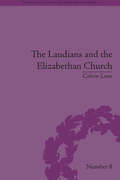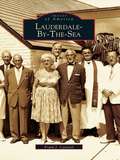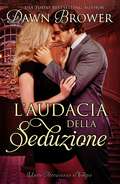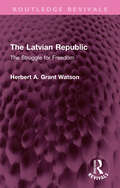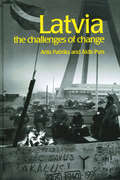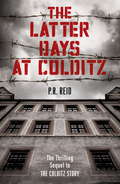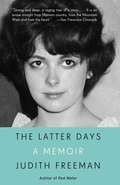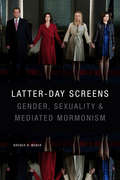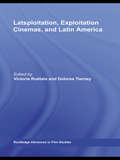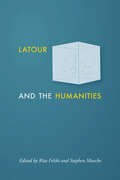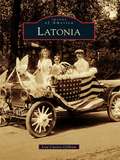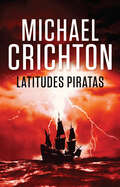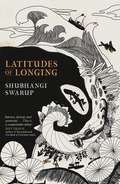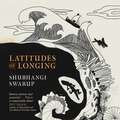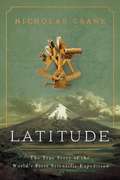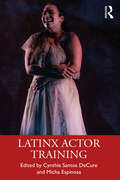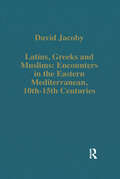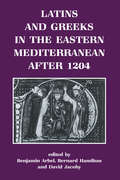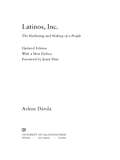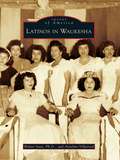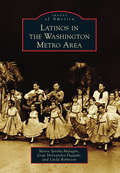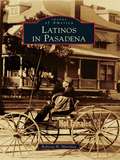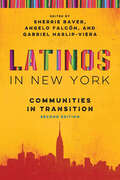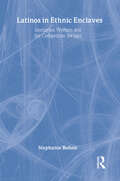- Table View
- List View
The Laudians and the Elizabethan Church: History, Conformity and Religious Identity in Post-Reformation England (Religious Cultures in the Early Modern World #8)
by Calvin LaneNotions of religious conformity in England were redefined during the mid-seventeenth century; for many it was as though the previous century's reformation was being reversed. Lane considers how a select group of churchmen – the Laudians – reshaped the meaning of church conformity during a period of religious and political turmoil.
Lauderdale-By-The-Sea (Images of America)
by Frank J. CavaioliLocated on Florida's Gold Coast, Lauderdale-By-The-Sea is noted for its beach activities, living reef system, and family-oriented lifestyle. The quiet beauty of the sea and sand amid friendly low-rise lodgings and quaint stores and restaurants draws visitors to this thriving paradise year-round. Lauderdale-By-The-Sea developed slowly around the original platted land set down by William F. Morang in 1924 as he and others promoted a land boom. The completion of the Flagler Railroad by 1900 paved the way for regional growth. Lauderdale-By-The-Sea lacked a railroad terminal and remained undeveloped in the early years. Melvin I. Anglin pioneered in chartering the town in 1927 and became its first mayor. Two hurricanes and the 1929 stock market crash burst the real estate bubble, leading to the demise of the charter in 1933. In 1947, citizens drew up a new charter that was certified by the state legislature two years later. Construction of the Anglin Pier in 1941 and the Commercial Boulevard Bridge over the Intracoastal Waterway in 1965 broke down the isolation of the town. Annexation of the unincorporated area north to Pompano Beach completed its growth cycle.
L'audacia della seduzione: Collegati attraverso il tempo
by Dawn BrowerCome si comporta un uomo quando è attratto da una donna che non può avere? Bradford Kendall, il duca di Weston, si trova proprio in questa situazione difficile quando l’ex moglie di suo fratello si presenta alla sua tenuta. Regina aveva da sempre nutrito un forte sentimento nei confronti di Bradford e ciò si rivela particolarmente difficile da tenere a bada. Regina Dewitt intende scoprire cosa sia successo a sua sorella. Il miglior posto per iniziare la sua ricerca è proprio il luogo in cui era scomparsa: Weston Manor. Era passato ormai un anno, e gli indizi scarseggiavano, ma Regina è determinata. Non aveva messo in conto quanto potesse tentarla il duca che stabilmente abita nella tenuta. Iniziando la ricerca insieme, la domanda da porsi è sempre la stessa: saranno in grado di combattere il loro sempre più acceso desiderio?
The Latvian Republic: The Struggle for Freedom (Routledge Revivals)
by Herbert A. WatsonFirst published in 1965, The Latvian Republic is based on the official British documents, partly on German and other writings of the period and of the author’s own experiences on a mission to Baltic Provinces in 1919. Throughout the centuries of foreign domination and the determination of their rulers to stamp out all vestiges of nationalism, the national spirit of the Latvian people survived, and they remained united in the hope of achieving, one day, the state of independent nationhood. With the collapse of the Russian Empire towards the end of the First World War, their dream became reality. A Latvian Provisional Government was formed and in November 1918 the Latvians declared themselves an independent republic, encouraged by the declaration of President Wilson in favour of the self-determination of all peoples and of all nations. This book will be of interest to students of history and political science.
Latvia: The Challenges of Change (Postcommunist States and Nations)
by Artis Pabriks Aldis PursThe past one hundred years have been a very trying time for Latvia, complete with success, tragedy, and still unrealized promise. Within the course of a generation, the country experienced revolutions, wars and independent statehood, and then the slide into authoritarianism. World War II brought new occupations. The tragedies were staggering: holocaust, executions, and an exodus of refugees. Soviet consolidation bred deportations, forced collectivization and partisan warfare. Almost fifty years later, Latvia regained its independence and emerged from decades of disastrous Soviet rule.This book comprehensively surveys Latvia's recent past and prospects for the new millennium, placing contemporary events in historical perspective. The authors address the evolution of the country from the movement against Soviet rule to the dilemmas of contemporary politics: party formation, the problem of corruption, the quest for the future and a regional and international role, the struggle to develop a civil society, the issue of ethnic relations and the recurring tendency towards statist solutions. Proper attention is also given to economic developments.
The Latter Days at Colditz
by Major P ReidIn THE COLDITZ STORY, Pat Reid told the story of the escape academythat sprang up inside the most impregnable German POW camp of the Second World War, ending appropriately with his own incredible escape from Colditz. But Reid's own break-out was by no means the last. In this enthralling sequel, he follows the fortunes of the escape academy right up until the arrival of the allied forces in April 1945. These tales of fantastic bravery and stunning ingenuity are every bit as mesmerising as the original.A true classic, LATTER DAYS AT COLDITZ is the bestselling conclusion to the story of the infamous German P.O.W. camp.
The Latter Days at Colditz
by Major R ReidIn THE COLDITZ STORY, Pat Reid told the story of the escape academythat sprang up inside the most impregnable German POW camp of the Second World War, ending appropriately with his own incredible escape from Colditz. But Reid's own break-out was by no means the last. In this enthralling sequel, he follows the fortunes of the escape academy right up until the arrival of the allied forces in April 1945. These tales of fantastic bravery and stunning ingenuity are every bit as mesmerising as the original.A true classic, LATTER DAYS AT COLDITZ is the bestselling conclusion to the story of the infamous German P.O.W. camp.
The Latter Days: A Memoir
by Judith FreemanAn arresting, lyrical memoir about the path the author took--sometimes unwittingly--out of her Mormon upbringing and through a thicket of profound difficulties to become a writer. At twenty-two, Judith Freeman was working in the Mormon church-owned department store in the Utah town where she'd grown up. In the process of divorcing the man she had married at seventeen, she was living in her parents' house with her four-year-old son, who had already endured two heart surgeries. She had abandoned Mormonism, the faith into which she had been born, and she was having an affair with her son's surgeon, a married man with three children of his own. It was at this fraught moment that she decided to become a writer. In this moving memoir, Freeman explores the circumstances and choices that informed her course, and those that allowed her to find a way forward. Writing with remarkable candor and insight, she gives us an illuminating, singular portrait of resilience and forgiveness, of memory and hindsight, and of the ways in which we come to identify our truest selves.(With black-and-white photographs throughout.)From the Hardcover edition.
Latter-day Screens: Gender, Sexuality, and Mediated Mormonism
by Brenda R. WeberFrom Sister Wives and Big Love to The Book of Mormon on Broadway, Mormons and Mormonism are pervasive throughout American popular media. In Latter-day Screens, Brenda R. Weber argues that mediated Mormonism contests and reconfigures collective notions of gender, sexuality, race, spirituality, capitalism, justice, and individualism. Focusing on Mormonism as both a meme and an analytic, Weber analyzes a wide range of contemporary media produced by those within and those outside of the mainstream and fundamentalist Mormon churches, from reality television to feature films, from blogs to YouTube videos, and from novels to memoirs by people who struggle to find agency and personhood in the shadow of the church's teachings. The broad archive of mediated Mormonism contains socially conservative values, often expressed through neoliberal strategies tied to egalitarianism, meritocracy, and self-actualization, but it also offers a passionate voice of contrast on behalf of plurality and inclusion. In this, mediated Mormonism and the conversations on social justice that it fosters create the pathway toward an inclusive, feminist-friendly, and queer-positive future for a broader culture that uses Mormonism as a gauge to calibrate its own values.
Latsploitation, Exploitation Cinemas, and Latin America (Routledge Advances in Film Studies)
by Victoria Ruétalo Dolores TierneyExploring the much neglected area of Latin American exploitation cinema, this anthology challenges established continental and national histories and canons which often exclude exploitation cinema due to its perceived ‘low’ cultural status. It argues that Latin American exploitation cinema makes an important aesthetic and social contribution to the larger body of Latin American cinema – often competing with Hollywood and more mainstream national cinemas in terms of popularity.
Latour and the Humanities
by Rita Felski and Stephen MueckeHow does the work of influential theorist Bruno Latour offer a fresh angle on the practices and purposes of the humanities?In recent years, defenses of the humanities have tended to argue along predictable lines: the humanities foster empathy, the humanities encourage critical thinking, the humanities offer a counterweight to the cold calculations of the natural and social sciences. The essays in Latour and the Humanities take a different approach. Exploring the relevance of theorist Bruno Latour's work, they argue for attachments and entanglements between the humanities and the sciences while looking closely at the interests, institutions, and intellectual projects that shape the humanities within and beyond the university. The collection, which is written by a group of highly distinguished scholars from around the world, is divided into two sections. In the first part, authors engage in depth with Latour's work while also rethinking the ties between the humanities and the sciences. Essays argue for greater attention to the nonhuman world, the urgency of climate change, and more nuanced views of universities as institutions. The second half of the volume contains essays that reflect on Latour's influence on the practices of specific disciplines, including art, the digital humanities, film studies, and political theory.Inspiring conversation about the relevance of actor-network-theory for research and teaching in the humanities, Latour and the Humanities offers a substantial introduction to Latour's work while discussing the humanities without falling back on the genres of either the sermon or the jeremiad. This volume will be of interest to all those searching for fresh perspectives on the value and importance of humanistic disciplines and thought.Contributors: David J. Alworth, Anders Blok, Claudia Breger, Dipesh Chakrabarty, Yves Citton, Steven Connor, Gerard de Vries, Simon During, Rita Felski, Francis Halsall, Graham Harman, Antoine Hennion, Casper Bruun Jensen, Bruno Latour, Heather Love, Patrice Maniglier, Stephen Muecke, Barbara Herrnstein Smith, Nigel Thrift, Michael Witmore
Latonia
by Lisa Curtiss GillhamThe Latonia Racetrack, opened in 1883, was one of the country's finest. Its presence spurred development, and the resulting town eventually took its name from the famous track. Latonia flourished with the help of the railroad, which carried visitors into town and hauled coal from the mining regions of southeastern Kentucky. The racetrack and railroad made Latonia a bustling center of activity and brought characters from all walks of life. Railroaders and stable boys tipped their hats to wealthy celebrities arriving to play the odds at the track. Famous jockeys, church-going housewives, and con men crossed paths at the racetrack and at Ritte's Corner. Named for a saloon, Ritte's Corner was considered the heart of Latonia, and it was a place where townspeople gathered to socialize, swap stories, and get the latest news. In 1909, Latonia was annexed by Covington, but it continues to be a neighborhood with its own identity and a place families call home, generation after generation.
Latitudes piratas
by Michael CrichtonLa novela póstuma del autor: una gran aventura de piratas, llena de acción y suspense, que trasladará a los lectores al Caribe del siglo XVII. El Caribe, 1665. La isla de Jamaica, colonia lejana de la corona inglesa, muestra su resistencia al asedio del gran Imperio español. La capital, Port Royal, es una ciudad peligrosa plagada de posadas, borrachos, peleas y burdeles. Cuando El Trinidad, un galeón español cargado de oro, fondea en una bahía cercana a la ciudad a la espera de ser reparado, el bucanero inglés Charles Hunter urde un plan extremadamente audaz. Con el apoyo extraoficial del gobernador de la isla, su ataque al galeón es uno de los más atrevidos y sangrientos de la historia real de la piratería. Reseña:«El talento de Michael Crichton fue aún más colosal que sus propios dinosaurios en Parque Jurásico.»Steven Spielberg
Latitudes of Longing: A prizewinning literary epic of the subcontinent, nature, climate and love
by Shubhangi Swarup** The phenomenal Indian bestseller ** **Winner of the Tata Lit Live Best First Book of the Year Award **'Intense, lyrical, and powerful. This is a remarkable debut' Jeet Thayil, author of Narcopolis and The Book of Chocolate Saints'Latitudes of Longing is a book to be savoured' The Hindu 'Bold and imaginative' India TodayA prizewinning literary epic of the subcontinent, for readers of Yaa Gyasi's HOMEGOING and Chimamanda Ngozi Adichie's HALF OF A YELLOW SUN In the feverish tropics of the Andaman Islands, a young botanist tends to a fragile rose he has imported to welcome his bride. Hoping their marriage will bloom in this strange life, hundreds of miles from the east coast of India, he is entranced by Chanda Devi's fierce nature and unusual gifts; speaking to trees and the ghosts of former colonialists. These islands, she tells her adoring husband, rest on a faultline, cracked so deep into the earth that spirits cross the boundary freely. But it is not this fracture that takes a tragic bite out of their happiness.With the family riven by heartbreak, their maid takes the chance to resolve her own past mistakes. Having abandoned her son many years before, she now traces him to Myanmar, only to find him in prison - the enemy of a brutal regime. The faultline she followed over the Indian Ocean now cuts north into Nepal, where the prisoner's ally, an itinerant drug dealer, tries to rescue a young woman from the dancing bars of Kathmandu. It shadows his footsteps into the Karakoram mountains, where a scientist looks deep into the abyss between India and Pakistan. It rises all the way to the snow deserts, beyond the reach of nation or war, where an elder of the village waits for the return of his true love, bringing all their journeys full circle.A breathtaking epic, Latitudes of Longing possesses the reader with a blazing sense of wonder. Shubhangi Swarup's vision goes deeper than the human stories of the subcontinent to reveal the conscious history of the earth itself. Tender in every detail, touched with humour and profound humanity, this is a novel brimming with life, an original masterpiece.
Latitudes of Longing: A prizewinning literary epic of the subcontinent, nature, climate and love
by Shubhangi Swarup* The phenomenal Indian bestseller * Winner of the Tata Lit Live Best First Book of the Year Award *'Intense, lyrical, and powerful. This is a remarkable debut' Jeet Thayil, author of Narcopolis and The Book of Chocolate SaintsIn the feverish tropics of the Andaman Islands, a young botanist tends to a fragile rose he has imported to welcome his bride. Hoping their marriage will bloom in this strange life, hundreds of miles from the east coast of India, he is entranced by Chanda Devi's fierce nature and unusual gifts; speaking to trees and the ghosts of former colonialists. These islands, she tells her adoring husband, rest on a faultline, cracked so deep into the earth that spirits cross the boundary freely. But it is not this fracture that takes a tragic bite out of their happiness.With the family riven by heartbreak, their maid takes the chance to resolve her own past mistakes. Having abandoned her son many years before, she now traces him to Myanmar, only to find him in prison - the enemy of a brutal regime. The faultline she followed over the Indian Ocean now cuts north into Nepal, where the prisoner's ally, an itinerant drug dealer, tries to rescue a young woman from the dancing bars of Kathmandu. It shadows his footsteps into the Karakorum mountains, where a scientist looks deep into the abyss between India and Pakistan. It rises all the way to the snow deserts, beyond the reach of nation or war, where an elder of the village waits for the return of his true love, bringing all their journeys full circle.A breathtaking epic, Latitudes of Longing possesses the reader with a blazing sense of wonder. Shubhangi Swarup's vision goes deeper than the human stories of the subcontinent to reveal the conscious history of the earth itself. Tender in every detail, touched with humour and profound, this is a novel brimming with life, an original masterpiece.(P)2020 Quercus Editions Limited
Latitude: The True Story of the World's First Scientific Expedition
by Nicholas CraneLatitude is a gloriously exciting tale of adventure and scientific discovery that has never been told before.Crane, the former president of the Royal Geographic Society, documents the remarkable expedition undertaken by a group of twelve European adventurer-scientists in the mid-eighteenth century. The team spent years in South America, scaling volcanoes and traversing jungles before they achieved their goal of establishing the exact shape of the Earth by measuring the length of 1 degree latitude at the equator. Their endeavors were not limited to this one achievement. Not only did their discovery open up the possibility for safe, accurate navigation across the seas, they also discovered rubber and quinine. With a narrative that reads like it was taken from the script of an adventure movie, Nicholas Crane brings to life a narrative that is a timely remind of how scientific discovery can change the world and our future. By knowing the shape of the earth we can create maps, survive the oceans, navigate the skies, and travel across the globe. Without latitude, maps and navigation wouldn&’t be accurate, lives would have been lost, and exact locations of cities and rivers would never be known. After ten grueling years in search of a magic number, the survivors returned to Europe with their historical discovery and fueled the public&’s interest in science. Twent-five years ago, Dava Sobel&’s bestselling Longitude was a global publishing phenomenon, yet it told only one half of the story. With Latitude, this cornerstone piece of our shared history is now complete with this tale of a trip that changed the course of human civilization. Filled with raw excitement and danger, Latitude brings the challenges that faced these explorer-scientists to vivid life.
Latinx Actor Training
by Cynthia Santos DeCure Micha EspinosaLatinx Actor Training presents essays and pioneering research from leading Latinx practitioners and scholars in the United States to examine the history and future of Latino/a/x/e actor training practices and approaches. Born out of the urgent need to address the inequities in academia and the industry as Latinx representation on stage and screen remains disproportionately low despite population growth; this book seeks to reimagine and restructure the practice of actor training by inviting deep investigation into heritage and identity practices. Latinx Actor Training features contributions covering current and historical acting methodologies, principles, and training, explorations of linguistic identity, casting considerations, and culturally inclusive practices that aim to empower a new generation of Latinx actors and to assist the educators who are entrusted with their training. This book is dedicated to creating career success and championing positive narratives to combat pervasive and damaging stereotypes. Latinx Actor Training offers culturally inclusive pedagogies that will be invaluable for students, practitioners, and scholars interested in the intersections of Latinx herencia (heritage), identity, and actor training.
Latins, Greeks and Muslims: Encounters in the Eastern Mediterranean, 10th-15th Centuries
by David JacobyTrade, shipping, military conquest, migration and settlement in the eastern Mediterranean of the 10th-15th centuries generated multiple encounters between states, social and 'national' groups, and individuals belonging to Latin Christianity, Byzantium and the Islamic world. The nature of these encounters varied widely, depending on whether they were the result of cooperation, rivalry or clashes between states, the outcome of Latin conquest, which altered the social and legal status of indigenous subjects, or the result of economic activity. They had wide-ranging social and economic repercussions, and shaped both individual and collective perceptions and attitudes. These often differed, depending upon 'nationality', standing within the dominant or subject social strata, or purely economic considerations. In any event, at the individual level common economic interests transcended collective 'national' and cultural boundaries, except in times of crisis. The studies in this latest collection by David Jacoby explore the multiple facets of these eastern Mediterranean encounters and their impact upon individual economic activities, with special attention to the 'other', outsiders in foreign environments, foreign privileged versus indigenous traders, the link between governmental intervention, 'naturalization', and fiscal status, as well as the interaction between markets and peasants.
Latins and Greeks in the Eastern Mediterranean After 1204
by David Jacoby Bernard Hamilton Benjamin ArbelFirst published in 1989. Routledge is an imprint of Taylor & Francis, an informa company.
Latinos, Inc.
by Arlene DávilaBoth Hollywood and corporate America are taking note of the marketing power of the growing Latino population in the United States. And as salsa takes over both the dance floor and the condiment shelf, the influence of Latin culture is gaining momentum in American society as a whole. Yet the increasing visibility of Latinos in mainstream culture has not been accompanied by a similar level of economic parity or political enfranchisement. In this important, original, and entertaining book, Arlene Dávila provides a critical examination of the Hispanic marketing industry and of its role in the making and marketing of U.S. Latinos. Dávila finds that Latinos' increased popularity in the marketplace is simultaneously accompanied by their growing exotification and invisibility. She scrutinizes the complex interests that are involved in the public representation of Latinos as a generic and culturally distinct people and questions the homogeneity of the different Latino subnationalities that supposedly comprise the same people and group of consumers. In a fascinating discussion of how populations have become reconfigured as market segments, she shows that the market and marketing discourse become important terrains where Latinos debate their social identities and public standing.
Latinos in Waukesha (Images of America)
by Walter Sava Anselmo VillarrealWaukesha's Latino community continues to keep pace with the growth that has characterized Latino demographics in the last 20 years. About 15,000 Latinos are now Waukesha County residents, and there are very unique qualities ascribed to this community. A significant number of Latinos can trace their Waukesha roots to the early 1920s and 1930s. The vast majority of Latinos who came to Waukesha ended up working in foundries, and a significant number retired from those jobs. There are now many families who are third- and fourth-generation Latinos, and new arrivals continue to join friends and relatives already established in Waukesha.
Latinos in the Washington Metro Area (Images of America)
by Linda Robinson Jorge Hernandez-Fujigaki Maria Sprehn-MalagónThe Latino presence in the Washington, DC, metropolitan area has diverse roots and a rich history. The earlier residents were relatively small in number, but the Latino population increased dramatically in the late 20th century. Today, this unique Latino community is the 12th largest in the nation. While people of Salvadoran origin are the most numerous, this area is also home to those who hail from Mexico, Puerto Rico, Guatemala, Cuba, the Dominican Republic, Bolivia, Argentina, Chile, Colombia, Ecuador, Honduras, Nicaragua, Paraguay, Peru, Spain, Uruguay, and many other nations and cultures. This book highlights the early days of the Hispanic Festival, the Central American peace movement, the struggle for civil and immigrants� rights, and notable residents. With a shared immigrant experience and broad cultural bonds, these and many other Latino residents have transformed the Washington, DC, area.
Latinos in Pasadena (Images of America)
by Roberta H. MartinezHistories of Pasadena are rich in details about important citizens, time-honored traditions, and storied enclaves such as Millionaires Row and Lamanda Park. But the legacies of Mexican Americans and other Latino men and women who often worked for Pasadena's rich and famous have been sparsely preserved through the generations--even though these citizens often made remarkable community contributions and lived in close proximity to their employers. A fuller story of the Pasadena area can be provided from these vintage images and the accompanying information culled from anecdotes, master's theses, newspaper articles, formal and informal oral histories, and the Ethnic History Research Project compiled for the City of Pasadena in 1995. Among the stories told is that of Antonio F. Coronel, a one-time Mexican Army officer who served as California state treasurer from 1866 to 1870 and whose image graced the 1904 Tournament of Roses program.
Latinos in New York: Communities in Transition (Latino Perspectives Ser.)
by Sherrie BaverSignificant changes in New York City's Latino community have occurred since the first edition of Latinos in New York: Communities in Transition was published in 1996. The Latino population in metropolitan New York has increased from 1.7 million in the 1990s to over 2.4 million, constituting a third of the population spread over five boroughs. Puerto Ricans remain the largest subgroup, followed by Dominicans and Mexicans; however, Puerto Ricans are no longer the majority of New York's Latinos as they were throughout most of the twentieth century.Latinos in New York: Communities in Transition, second edition, is the most comprehensive reader available on the experience of New York City's diverse Latino population. The essays in Part I examine the historical and sociocultural context of Latinos in New York. Part II looks at the diversity comprising Latino New York. Contributors focus on specific national origin groups, including Ecuadorians, Colombians, and Central Americans, and examine the factors that prompted emigration from the country of origin, the socioeconomic status of the emigrants, the extent of transnational ties with the home country, and the immigrants' interaction with other Latino groups in New York. Essays in Part III focus on politics and policy issues affecting New York's Latinos. The book brings together leading social analysts and community advocates on the Latino experience to address issues that have been largely neglected in the literature on New York City. These include the role of race, culture and identity, health, the criminal justice system, the media, and higher education, subjects that require greater attention both from academic as well as policy perspectives.Contributors: Sherrie Baver, Juan Cartagena, Javier Castaño, Ana María Díaz-Stevens, Angelo Falcón, Juan Flores, Gabriel Haslip-Viera, Ramona Hernández, Luz Yadira Herrera, Gilbert Marzán, Ed Morales, Pedro A. Noguera, Rosalía Reyes, Clara E. Rodríguez, José Ramón Sánchez, Walker Simon, Robert Courtney Smith, Andrés Torres, and Silvio Torres-Saillant.
Latinos in Ethnic Enclaves: Immigrant Workers and the Competition for Jobs (Latino Communities: Emerging Voices - Political, Social, Cultural and Legal Issues)
by Stephanie BohonThis work explores the competition for jobs between different Latin American immigrant groups in the U.S. economy. Bohon's research looks at occupational status attainment among Latino groups in Miami and three other U.S. cities with flourishing Latino enclaves.
